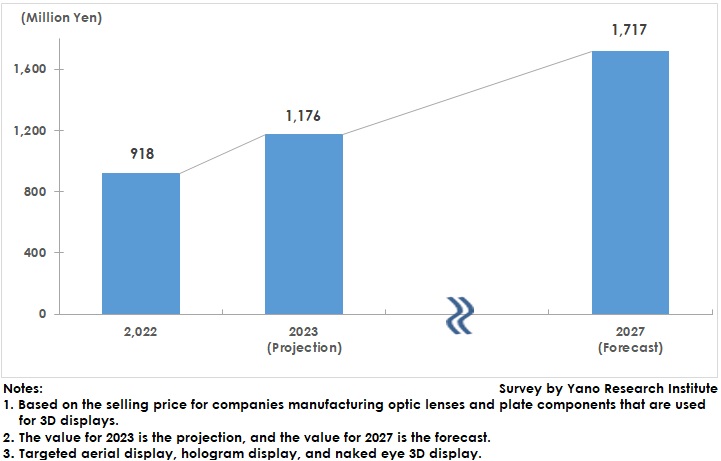No.3433
Three-Dimensional (3D) Display Market in Japan: Key Research Findings 2023
3D Display Component Market Size in Japan Projected to Reach 1,176 Million Yen in 2023
Yano Research Institute (the President, Takashi Mizukoshi) has surveyed the three-dimensional (3D) display market in Japan and has found out the trends by part and by market player, and future perspectives. Disclosed here is the 3D display component market size.

Market Overview
Optical devices and principles used in aerial displays, holographic displays and naked-eye 3D displays were already discovered more than a hundred years ago. At that time, however, it was difficult to develop necessary technologies for the principle, which led the product development for a three-dimensional (3D) display remained at a certain level of performance.
Nowadays, the environment has been overall prepared for establishing related technologies and for product development, which is expected for demand expansion for 3D displays and for manufacturing technology to be in progress, including that of a 3D display.
This research targets three types of 3D displays, i.e., aerial display, holographic display, and naked-eye 3D display. The market size for 3D display components, that are optical lenses, plate components, etc. used for these 3D displays in Japan is projected to reach 918 million yen in 2022, and 1,176 million yen by 2023, a rise to 128.1% on YoY, based on the manufacturer selling price.
The market was sluggish after 2020 due to COVID-19 crisis, because of extremely decreased exhibitions and events that let users see and experience the real products. By 2023, as physical events increased after the lift of behavior restrictions, use of 3D displays boosted for product appeal and exhibitions at companies attending such events, thus, the market has been on the course of recovery. With the clients for the display implementation being underway and the awareness improving, more companies have started implementation or considering the implementation.
Noteworthy Topics
Vigorous Strategy Planning Underway, Aiming to Encourage Implementation at Automotive Industry, the Japan’s Forte
Implementation of 3D displays, such as aerial or holographic displays, as automotive displays are in consideration.
Whatever the component or a part, five years or so of time period are needed for consideration until being implemented in the automotive industry, as the safety and manufacturing line certifications are needed. 3D displays have long been repetitively developed and improved the products behind the scenes for being approved of strict certification processes in the automotive industry.
In particular, aerial displays have been in the process of establishing full-scale product technology since the 2020s, but, there still are a pile of challenges to be solved, such as high costs and thickness of enclosure.
The industry has targeted the implementation of 3D displays in cars for 2030s, expecting the realization of near-future automobiles that allow users to drive while operating information reflected in the air.
Future Outlook
In the latter half of 2020s, aerial and holographic displays, among all 3D displays, are likely to be in adjustment for mass production in each company that has been developing products of prototype levels. The 3D display component market size is anticipated to expand to 1,717 million yen by 2027, as the unit price of optical lenses and plate components subsides and as the demand for 3D displays increases.
When compared to existing flat displays that use LED with matured technology, 3D displays are inferior in the thickness of enclosure. Still, there are advantages that can only be achieved by 3D displays, such as aerial projection technology and added value that comes with it (impacts, images highly influential on viewers, etc.)
By expanding implementations, 3D displays have potential to make users to enjoy in various industries including mobility and entertainment.
Research Outline
2.Research Object: Domestic companies dealing in aerial displays, holographic displays, and naked-eye 3D displays
3.Research Methogology: Face-to-face interviews (including online) by expert researchers, and literature research
Three-Dimensional (3D) Displays
Of those products categorized as 3D displays, this research targets the following three: Aerial display, holographic display, and naked eye 3D display.
An aerial display is the technology that makes the information on display to be reflected in the air. If the appliance has interactive functions, users can operate without touching displays.
A holographic display can create three-dimensional images closer to real things by utilizing single holographic technology that produce hologram or by combining digital technology.
Just like aerial and holographic displays, a naked-eye 3D display is the technology that enables to see three-dimensional images with naked eyes without wearing a HMD or 3D glasses. This is a generic name of the technologies for three dimensional images in sizes of household TVs or digital signage.
Three-Dimensional (3D) Display Component Market
3D display component market in this research is calculated based on the selling price for companies manufacturing optic lenses and plate components that are used for 3D displays.
<Products and Services in the Market>
Aerial display, holographic display, naked eye 3D display
Published Report
Contact Us
The copyright and all other rights pertaining to this report belong to Yano Research Institute.
Please contact our PR team when quoting the report contents for the purpose other than media coverage.
Depending on the purpose of using our report, we may ask you to present your sentences for confirmation beforehand.